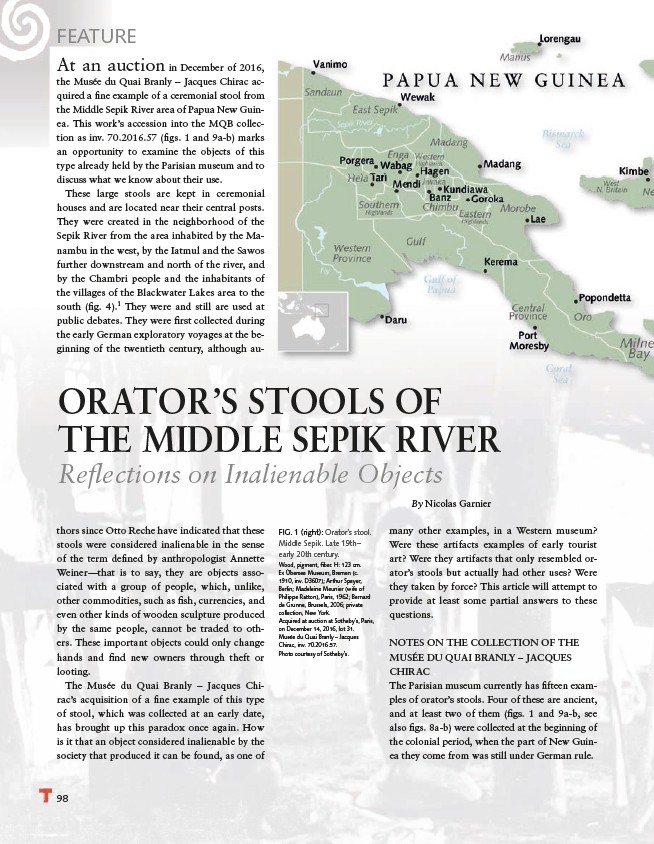
At an auction in December of 2016,
the Musée du Quai Branly – Jacques Chirac acquired
ORATOR’S STOOLS OF
THE MIDDLE SEPIK RIVER
Refl ections on Inalienable Objects
98
a fi ne example of a ceremonial stool from
the Middle Sepik River area of Papua New Guinea.
This work’s accession into the MQB collection
as inv. 70.2016.57 (fi gs. 1 and 9a-b) marks
an opportunity to examine the objects of this
type already held by the Parisian museum and to
discuss what we know about their use.
These large stools are kept in ceremonial
houses and are located near their central posts.
They were created in the neighborhood of the
Sepik River from the area inhabited by the Manambu
in the west, by the Iatmul and the Sawos
further downstream and north of the river, and
by the Chambri people and the inhabitants of
the villages of the Blackwater Lakes area to the
south (fi g. 4).1 They were and still are used at
public debates. They were fi rst collected during
the early German exploratory voyages at the beginning
of the twentieth century, although authors
since Otto Reche have indicated that these
stools were considered inalienable in the sense
of the term defi ned by anthropologist Annette
Weiner—that is to say, they are objects associated
with a group of people, which, unlike,
other commodities, such as fi sh, currencies, and
even other kinds of wooden sculpture produced
by the same people, cannot be traded to others.
These important objects could only change
hands and fi nd new owners through theft or
looting.
The Musée du Quai Branly – Jacques Chirac’s
acquisition of a fi ne example of this type
of stool, which was collected at an early date,
has brought up this paradox once again. How
is it that an object considered inalienable by the
society that produced it can be found, as one of
many other examples, in a Western museum?
Were these artifacts examples of early tourist
art? Were they artifacts that only resembled orator’s
stools but actually had other uses? Were
they taken by force? This article will attempt to
provide at least some partial answers to these
questions.
NOTES ON THE COLLECTION OF THE
MUSÉE DU QUAI BRANLY – JACQUES
CHIRAC
The Parisian museum currently has fi fteen examples
of orator’s stools. Four of these are ancient,
and at least two of them (fi gs. 1 and 9a-b, see
also fi gs. 8a-b) were collected at the beginning of
the colonial period, when the part of New Guinea
they come from was still under German rule.
FEATURE
FIG. 1 (right): Orator’s stool.
Middle Sepik. Late 19th–
early 20th century.
Wood, pigment, fi ber. H: 123 cm.
Ex Übersee Museum, Bremen (c.
1910, inv. D3607); Arthur Speyer,
Berlin; Madeleine Meunier (wife of
Philippe Ratton), Paris, 1962; Bernard
de Grunne, Brussels, 2006; private
collection, New York.
Acquired at auction at Sotheby’s, Paris,
on December 14, 2016, lot 31.
Musée du Quai Branly – Jacques
Chirac, inv. 70.2016.57.
Photo courtesy of Sotheby’s.
By Nicolas Garnier